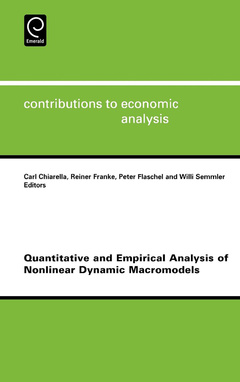Description
Quantitative and empirical analysis of nonlinear dynamic macromodels
Authors: CHIARELLA Carl, FRANKE Reiner, FLASCHEL Peter, SEMMLER Willi
Language: English
Approximative price 127.94 €
Subject to availability at the publisher.
Add to cart
Publication date: 04-2006
562 p. · Hardback
562 p. · Hardback
Description
/li>Contents
/li>Readership
/li>
This book represents an ongoing research agenda the aim of which is to contribute to the Keynesian paradigm in macroeconomics. A currently dominant research strategy in macroeconomics is based on the Dynamic General Equilibrium (DGE) model. Its essential features are the assumption of intertemporal optimizing behavior of economic agents, competitive markets and price mediated market clearing through flexible wages and prices.*Contributions to Economic Analysis was established in 1952*The series purpose is to stimulate the international exchange of scientific information*The series includes books from all areas of macroeconomics and microeconomics
1. Introduction. Part I: Phillips curve approaches and the wage-price spiral. 2. Wage-price Phillips curves and macroeconomic stability: Basic structural form, estimation and analysis (P. Flaschel, H-M. Krolzig). 3. Three wage-price macro models and their calibration (R. Franke). 4. The decomposition of the inflation-unemployment relationship by time scale using wavelets (M. Gallegati et al). 5. New Keynesian theory and the new Phillips curves: A new competing approach (P. Flaschel, E. Schlicht). Part II: Dynamic AD-AS analysis: Qualitative features, numerics and estimation. 6. Keynesian theory and the AD-AS framework: A reconsideration (A.K. Dutt, P. Skott). 7. AD-AS and the Phillips curve: A baseline disequilibrium model (T. Asada et al). 8. Keynesian macrodynamics and the Phillips curve: An estimated model for the U.S. Economy (P. Chen et al). 9. Advanced Keynes-Metzler-Goodwin macro modeling: A calibration study (R. Franke). Part III: Models of real-financial market interactions and capital accumulation. 10. A stochastic model of real-financial interaction with boundedly rational heterogeneous agents (C. Chiarella et al). 11. A high-dimensional model of real-financial market interaction: The cascade of stable matrices approach (C. Chiarella et al). 12. Currency crisis, financial crisis, and large output loss (P. Flaschel, W. Semmler). 13. Prosperity and stagnation in capitalist economies (T. Asada, P. Flaschel, P. Skott). Part IV: Monetary policy and inflation targeting. 14. Keynesian dynamics without the LM curve: Implications of underlying open market operations (R. Franke). 15. Nonlinear Phillips-curves, endogenous NAIRU and monetary policy (W. Semmler, W. Zhang). 16. Inflation targeting policy in a dynamic Keynesian model with debt accumulation: A Japanese perspective (T. Asada).
Economists
© 2024 LAVOISIER S.A.S.




